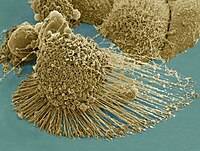
Effective Genome Editing Using CRISPR‐Cas9 Nanoflowers
Sign Up to like & getrecommendations! Published in 2022 at "Advanced Healthcare Materials"
DOI: 10.1002/adhm.202102365
Abstract: CRISPR‐Cas9 as a powerful gene‐editing tool has tremendous potential for the treatment of genetic diseases. Herein, a new mesoporous nanoflower (NF)‐like delivery nanoplatform termed Cas9‐NF is reported by crosslinking Cas9 and polymeric micelles that enables… read more here.
Keywords: genome editing; crispr cas9; effective genome; editing using ... See more keywords

Single nucleotide editing without DNA cleavage using CRISPR/Cas9‐deaminase in the sea urchin embryo
Sign Up to like & getrecommendations! Published in 2017 at "Developmental Dynamics"
DOI: 10.1002/dvdy.24586
Abstract: Background: A single base pair mutation in the genome can result in many congenital disorders in humans. The recent gene editing approach using CRISPR/Cas9 has rapidly become a powerful tool to replicate or repair such… read more here.
Keywords: crispr cas9; single nucleotide; nucleotide editing; sea urchin ... See more keywords

Genome-Wide PERV Inactivation in Pigs Using CRISPR/Cas9.
Sign Up to like & getrecommendations! Published in 2020 at "Methods in molecular biology"
DOI: 10.1007/978-1-0716-0255-3_10
Abstract: The shortage of organs for transplantation is probably the biggest unmet medical need. A potential problem with the clinical use of porcine xenografts is the risk that porcine endogenous retroviruses (PERVs) could infect human cells.… read more here.
Keywords: crispr cas9; genome wide; using crispr; wide perv ... See more keywords

Using CRISPR-Cas9 to Study ERK Signaling in Drosophila.
Sign Up to like & getrecommendations! Published in 2017 at "Methods in molecular biology"
DOI: 10.1007/978-1-4939-6424-6_26
Abstract: Genome engineering using the clustered regularly interspaced short palindromic repeats (CRISPR)-CRISPR associated nuclease 9 (Cas9) technology is revolutionizing biomedical research. CRISPR-Cas9 enables precise editing of genes in a wide variety of cells and organisms, thereby… read more here.
Keywords: drosophila; cas9 study; study erk; crispr cas9 ... See more keywords

Transcriptomic and physiological analysis of OsCAO1 knockout lines using the CRISPR/Cas9 system in rice.
Sign Up to like & getrecommendations! Published in 2020 at "Plant cell reports"
DOI: 10.1007/s00299-020-02607-y
Abstract: KEY MESSAGE The altered rice leaf color based on the knockout of CAO1 gene generated using CRISPR/Cas9 technology plays important roles in chlorophyll degradation and ROS scavenging to regulate both natural and induced senescence in… read more here.
Keywords: rice; crispr cas9; edited lines; oscao1 ... See more keywords

Playing Tag with Your Favorite GPCR Using CRISPR.
Sign Up to like & getrecommendations! Published in 2020 at "Cell chemical biology"
DOI: 10.1016/j.chembiol.2020.06.001
Abstract: In this issue of Cell Chemical Biology, White et al. (2020) describe CRISPR/Cas9-mediated tagging of GPCRs and β-arrestin to provide a method to study receptor signaling in cells under conditions of endogenous genetic control. The strategy,… read more here.
Keywords: playing tag; tag favorite; biology; gpcr using ... See more keywords

Generation of a Bag1 homozygous knockout mouse embryonic stem cell line using CRISPR/Cas9.
Sign Up to like & getrecommendations! Published in 2017 at "Stem cell research"
DOI: 10.1016/j.scr.2017.03.016
Abstract: Bag1 transcribes a multifunctional protein that participates in many important biological processes such as cell apoptosis, proliferation, differentiation and embryo development. Despite numerous published studies, the role of Bag1 in the context of embryonic stem… read more here.
Keywords: cell line; crispr cas9; stem cell; embryonic stem ... See more keywords

Generation of an ASS1 heterozygous knockout human embryonic stem cell line, WAe001-A-13, using CRISPR/Cas9.
Sign Up to like & getrecommendations! Published in 2018 at "Stem cell research"
DOI: 10.1016/j.scr.2017.11.007
Abstract: The ASS1 gene encodes argininosuccinate synthetase-1, a cytosolic enzyme with a critical role in the urea cycle. Mutations are found in all ASS1 exons and cause the autosomal recessive disorder citrullinemia. Using CRISPR/Cas9-editing, we established… read more here.
Keywords: stem cell; cell; cell line; using crispr ... See more keywords

Generation of Rybp homozygous knockout murine ES cell line GIBHe001-A-1 by using CRISPR/Cas9 technology.
Sign Up to like & getrecommendations! Published in 2019 at "Stem cell research"
DOI: 10.1016/j.scr.2019.101638
Abstract: RYBP (Ring1 and YY1 Binding Protein) is critical for pluripotency and differentiation of embryonic stem cells (ESCs). RYBP depletion disturbs both neural and myocardial differentiation of ESCs. Moreover, low level of RYBP is correlated with… read more here.
Keywords: crispr cas9; rybp homozygous; homozygous knockout; using crispr ... See more keywords

Generation of two isogenic knockout PKD2 iPS cell lines, IRFMNi003-A-1 and IRFMNi003-A-2, using CRISPR/Cas9 technology.
Sign Up to like & getrecommendations! Published in 2019 at "Stem cell research"
DOI: 10.1016/j.scr.2019.101667
Abstract: Autosomal dominant polycystic kidney disease (ADPKD) is the most prevalent inherited renal disease, characterized by multiple cysts that can lead to kidney failure resulting in end-stage renal disease. ADPKD is mainly caused by mutations in… read more here.
Keywords: two isogenic; crispr cas9; pkd2; cas9 technology ... See more keywords

Generation of a TLR7 heterozygous knockout line (WAe009-A-18) from human embryonic stem cells using CRISPR/Cas9.
Sign Up to like & getrecommendations! Published in 2020 at "Stem cell research"
DOI: 10.1016/j.scr.2020.101735
Abstract: Toll-like receptor 7 (TLR7) is a member of the toll-like receptor (TLR) family that is essential in the innate immune system. In this study, we established a heterozygous TLR7 knockout H9 cell line using CRISPR/Cas9.… read more here.
Keywords: generation tlr7; line; crispr cas9; using crispr ... See more keywords